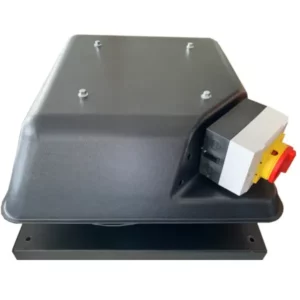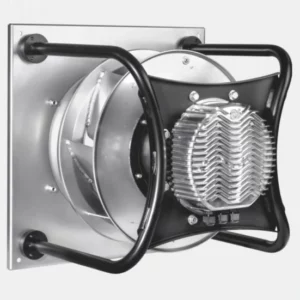Axial fans are a staple component across various industries due to their ability to efficiently move large volumes of air in a linear direction parallel to the shaft. This article delves into two specific voltage configurations of axial fans – the 120V and 24V models – and their application within the context of a critical ventilation system, the axial roof exhaust fan.

120V Axial Fan: Powering Large-Scale Ventilation
The 120V axial fan is commonly found in industrial and commercial settings where high power output and airflow capacity are essential. These electrically powered fans operate at standard household or commercial voltages and can handle significant loads, making them ideal for use in warehouses, factories, and large buildings. They excel in providing general ventilation, cooling, and heat removal, especially when integrated into HVAC systems or as standalone units.
In the context of an axial roof exhaust fan, a 120V model offers robust performance to expel stale indoor air, fumes, or excess heat from a building through the roof. By drawing air out of the interior and exhausting it to the atmosphere, these fans play a pivotal role in maintaining a healthy and comfortable indoor environment while reducing energy consumption by promoting natural air circulation.
Axial Roof Exhaust Fan: A Key Component in Building Efficiency
Axial roof exhaust fans are specifically designed for mounting on rooftops to manage the air quality and temperature inside large spaces. With their axial flow design, they effectively remove warm, contaminated, or humid air from inside structures and replace it with fresh outdoor air.
These fans are engineered to withstand harsh outdoor conditions, featuring weather-resistant materials and coatings that protect against corrosion and UV damage. Furthermore, many axial roof exhaust fans come equipped with variable speed controls, enabling users to adjust airflow rates according to the changing demands of the space, thereby optimizing energy efficiency.
Advantages of Axial Roof Exhaust Fan
Axial roof exhaust fans are critical components in maintaining proper ventilation and air quality within buildings, especially those with large interior spaces. They offer a multitude of advantages over other ventilation methods:
- Efficient Airflow Management: Axial fans are designed to generate high volumes of airflow at relatively low pressure. This design is perfect for exhausting hot or contaminated air from the top of buildings, where natural convection currents help to draw air outwards. The axial flow pattern ensures that air moves linearly through the fan, facilitating efficient extraction of stale indoor air.
- Broad Coverage Area: Installed on rooftops, axial exhaust fans can effectively service an entire building by drawing air from multiple points or ductwork systems, ensuring comprehensive air exchange throughout the structure.
- Temperature Control: These fans play a pivotal role in temperature regulation by expelling warm air during summer months, reducing cooling loads and helping HVAC systems operate more efficiently. In winter, they can be used to remove excess humidity, preventing condensation and mold growth.
- Versatility in Size and Power: Axial roof exhaust fans come in various sizes and power ratings to suit different space requirements and performance needs. They can handle everything from light residential applications to heavy-duty industrial environments.
- Energy Efficiency: Many models incorporate energy-saving features such as variable speed drives, allowing them to adjust their speed according to demand. This not only conserves energy but also extends the lifespan of the fan due to reduced wear and tear when operating at lower speeds.
Axial Fan 24V : Compact, Efficient, and Adaptable
A axial fan 24V represents a more specialized variant suitable for applications where lower voltage operation is necessary or preferred. These fans are often utilized in environments requiring low noise levels, minimal electrical consumption, or stringent safety standards.
In the realm of HVAC and ventilation, axial fans 24V are frequently used in smaller-scale systems, including those found in residential attics, modular buildings, and mobile homes. They also find applications in vehicles, caravans, and boats, where space is limited and power supply requirements differ from typical mains voltage.
Moreover, axial fans 24V can be integrated into sensitive electronic equipment cabinets or server rooms where overheating must be prevented without creating excessive noise. In some cases, they serve as auxiliary cooling components for rooftop exhaust systems, offering supplementary ventilation during peak demand periods.
Axial fans, whether operating at 120V or 24V, contribute significantly to the overall functionality and sustainability of diverse ventilation solutions, particularly when incorporated into roof exhaust systems. Their unique features allow for flexibility in installation and operation, ensuring optimal air movement and thermal management across a wide range of applications. As technology advances, these versatile fans continue to evolve, meeting the ever-changing needs of modern construction, industry, and infrastructure.


